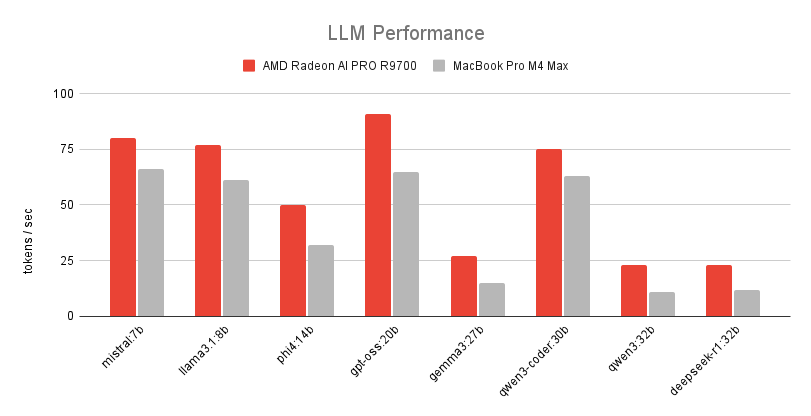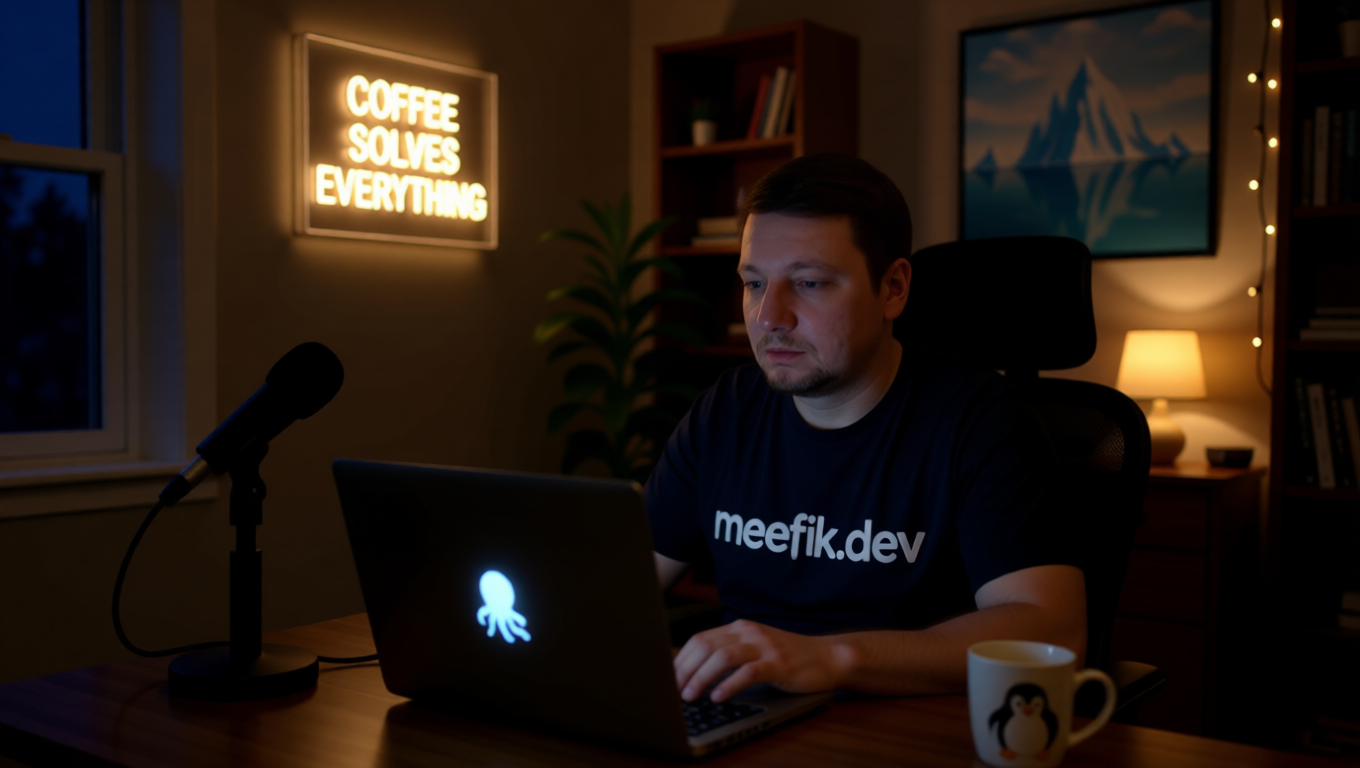LLM performance on AMD Radeon AI PRO R9700
Recently, I acquired an AMD Radeon AI PRO R9700 to enhance my machine learning and development setup. It is a powerful GPU designed for professional workloads, including machine learning and AI applications. In this post, we explore the performance of large language models (LLMs) on the R9700, highlighting its capabilities and benchmarks.

Hardware overview
The PC used for testing is equipped with the following specifications:
- Motherboard: B550 AORUS ELITE AX V2
- GPU: AMD Radeon AI PRO R9700 (32 GB VRAM, RDNA 4)
- CPU: AMD Ryzen 9 5950X (16 cores / 32 threads)
- RAM: 64 GB DDR4-2666
- Storage: NVMe Samsung SSD 970 EVO Plus 1TB
Setup environment
For testing LLM performance we set up the following environment:
The docker-compose.yml file used for the setup is as follows:
services:
ollama:
image: ollama/ollama:rocm
ports:
- 11434:11434
volumes:
- ollama:/root/.ollama
environment:
- 'HSA_OVERRIDE_GFX_VERSION=12.0.0'
devices:
- '/dev/kfd'
- '/dev/dri'
tty: true
restart: unless-stopped
open-webui:
image: ghcr.io/open-webui/open-webui:main
volumes:
- open-webui:/app/backend/data
depends_on:
- ollama
ports:
- 8080:8080
environment:
- 'OLLAMA_BASE_URL=http://ollama:11434'
- 'WEBUI_SECRET_KEY='
extra_hosts:
- host.docker.internal:host-gateway
restart: unless-stopped
volumes:
ollama:
open-webui:
Run these services with:
docker-compose up -d
Benchmark results
I used the following prompt for testing text generation performance:
Tell me a story about a brave knight who saves a village from a dragon.
Here are the benchmark results:
| Model | VRAM usage | Prompt | Response |
|---|---|---|---|
| mistral:7b | 6 GB | 414 tokens/sec | 80 tokens/sec |
| llama3.1:8b | 7 GB | 386 tokens/sec | 77 tokens/sec |
| phi4:14b | 12 GB | 213 tokens/sec | 50 tokens/sec |
| gpt-oss:20b | 13 GB | 704 tokens/sec | 91 tokens/sec |
| gemma3:27b | 19 GB | 207 tokens/sec | 27 tokens/sec |
| qwen3-coder:30b | 18 GB | 250 tokens/sec | 75 tokens/sec |
| qwen3:32b | 21 GB | 179 tokens/sec | 23 tokens/sec |
| deepseek-r1:32b | 22 GB | 99 tokens/sec | 23 tokens/sec |
For vision models that understand images, I used this image with the following prompt:
What is in this picture?

Here are the benchmark results:
| Model | VRAM usage | Prompt | Response |
|---|---|---|---|
| moondream:1.8b | 3 GB | 2156 tokens/sec | 188 tokens/sec |
| gemma3:4b | 5 GB | 1316 tokens/sec | 107 tokens/sec |
| gemma3n:e4b | 8 GB | 367 tokens/sec | 58 tokens/sec |
| llava:7b | 6 GB | 515 tokens/sec | 83 tokens/sec |
| qwen3-vl:8b | 11 GB | 423 tokens/sec | 73 tokens/sec |
| gemma3:27b | 19 GB | 171 tokens/sec | 27 tokens/sec |
| qwen3-vl:32b | 26 GB | 132 tokens/sec | 24 tokens/sec |
| llava:34b | 22 GB | 129 tokens/sec | 24 tokens/sec |
For comparison, here are the benchmark results for the same models from the MacBook Pro M4 Max (36 GB RAM, 14 cores).
Here are the benchmark results for models with text generation only:
| Model | Prompt | Response |
|---|---|---|
| mistral:7b | 208 tokens/sec | 66 tokens/sec |
| llama3.1:8b | 219 tokens/sec | 61 tokens/sec |
| phi4:14b | 91 tokens/sec | 32 tokens/sec |
| gpt-oss:20b | 62 tokens/sec | 65 tokens/sec |
| gemma3:27b | 11 tokens/sec | 15 tokens/sec |
| qwen3-coder:30b | 88 tokens/sec | 63 tokens/sec |
| qwen3:32b | 57 tokens/sec | 11 tokens/sec |
| deepseek-r1:32b | 48 tokens/sec | 12 tokens/sec |
For vision models that understand images, here are the results:
| Model | Prompt | Response |
|---|---|---|
| moondream:1.8b | 1706 tokens/sec | 180 tokens/sec |
| gemma3:4b | 995 tokens/sec | 81 tokens/sec |
| gemma3n:e4b | 39 tokens/sec | 46 tokens/sec |
| llava:7b | 640 tokens/sec | 65 tokens/sec |
| qwen3-vl:8b | 246 tokens/sec | 56 tokens/sec |
| gemma3:27b | 183 tokens/sec | 18 tokens/sec |
| qwen3-vl:32b | 76 tokens/sec | 15 tokens/sec |
| llava:34b | 143 tokens/sec | 16 tokens/sec |
Conclusion
The AMD Radeon AI PRO R9700 demonstrates strong performance across a variety of large language models, handling both text-only and vision-capable models effectively. With its substantial VRAM and robust architecture, the R9700 is well-suited for professional AI workloads, making it a compelling choice for developers and researchers working with LLMs. Now, I can take full advantage of AMD’s capabilities for my AI projects and code with local LLMs!
Comments